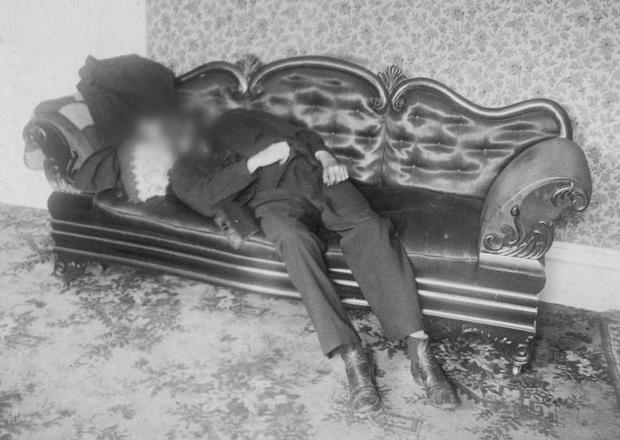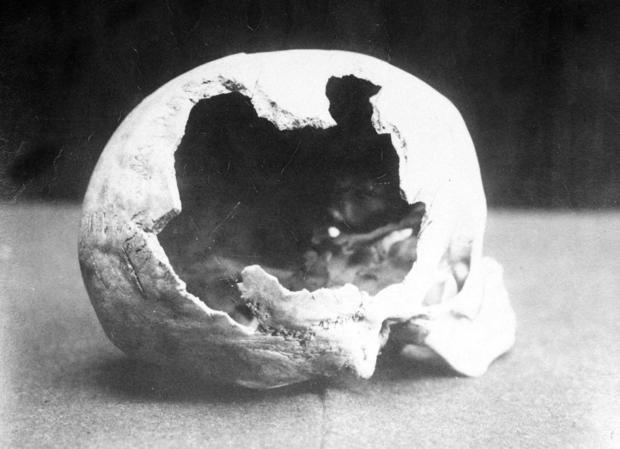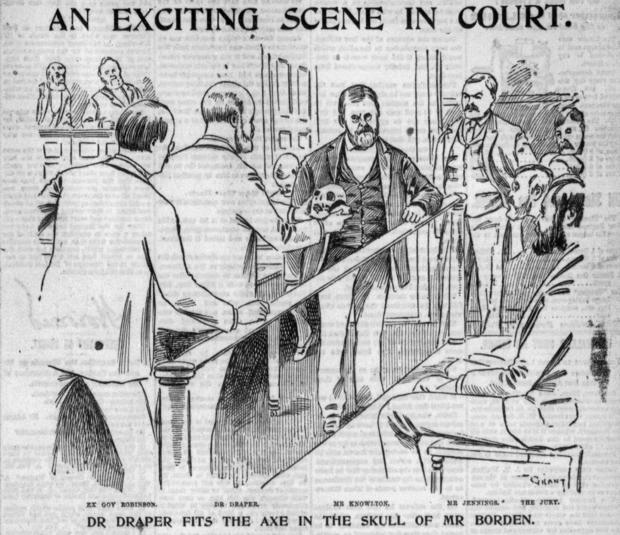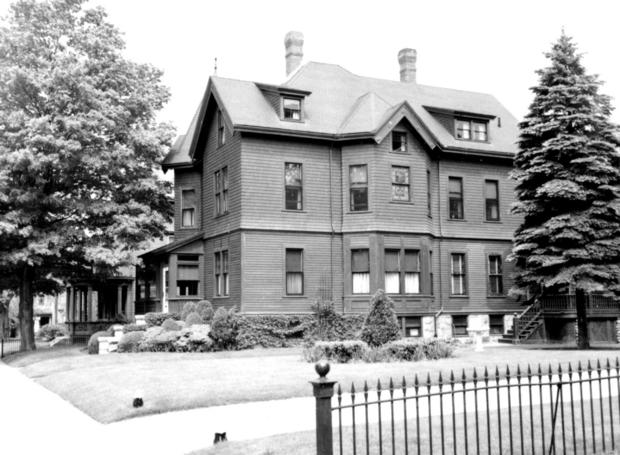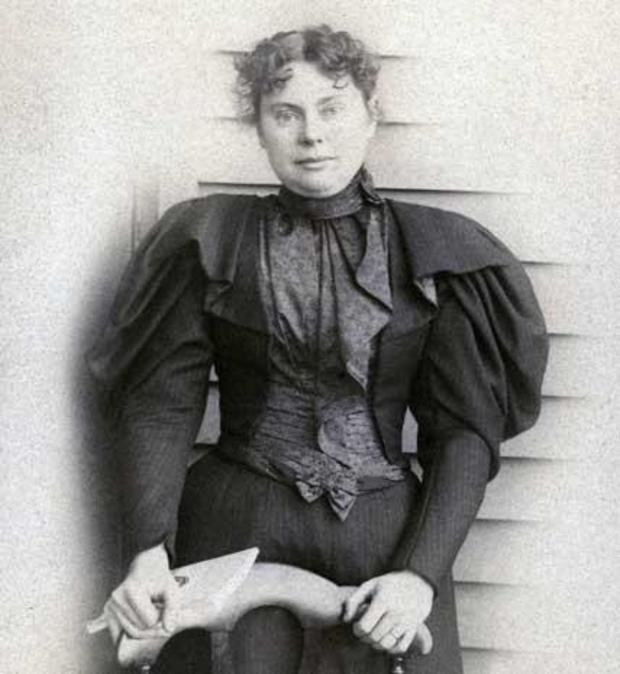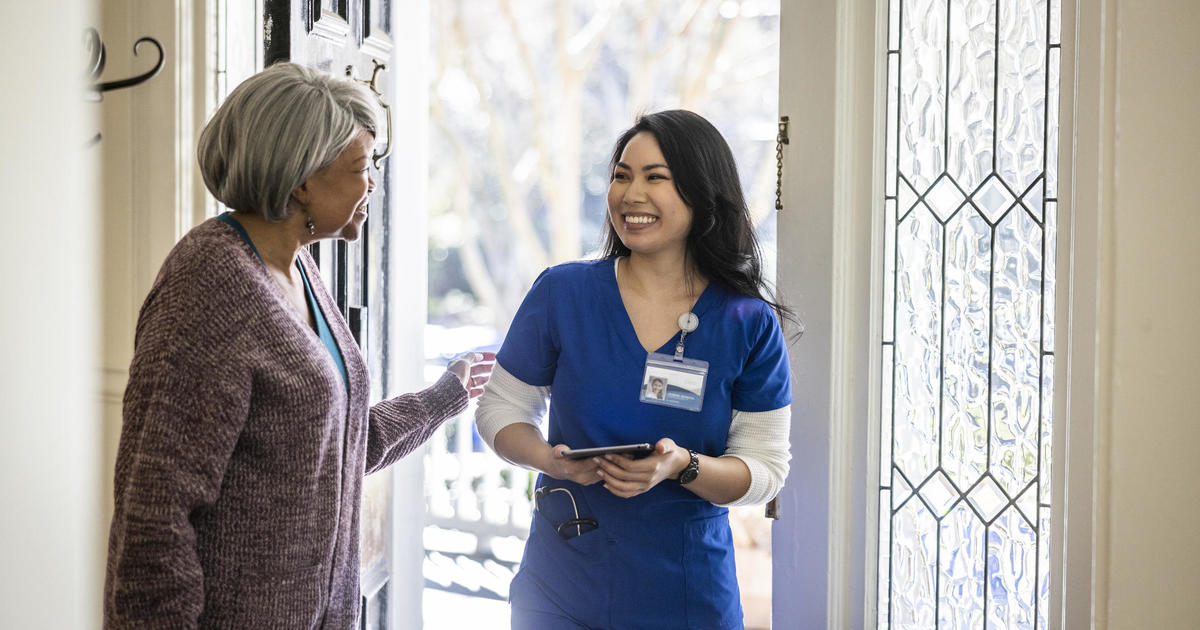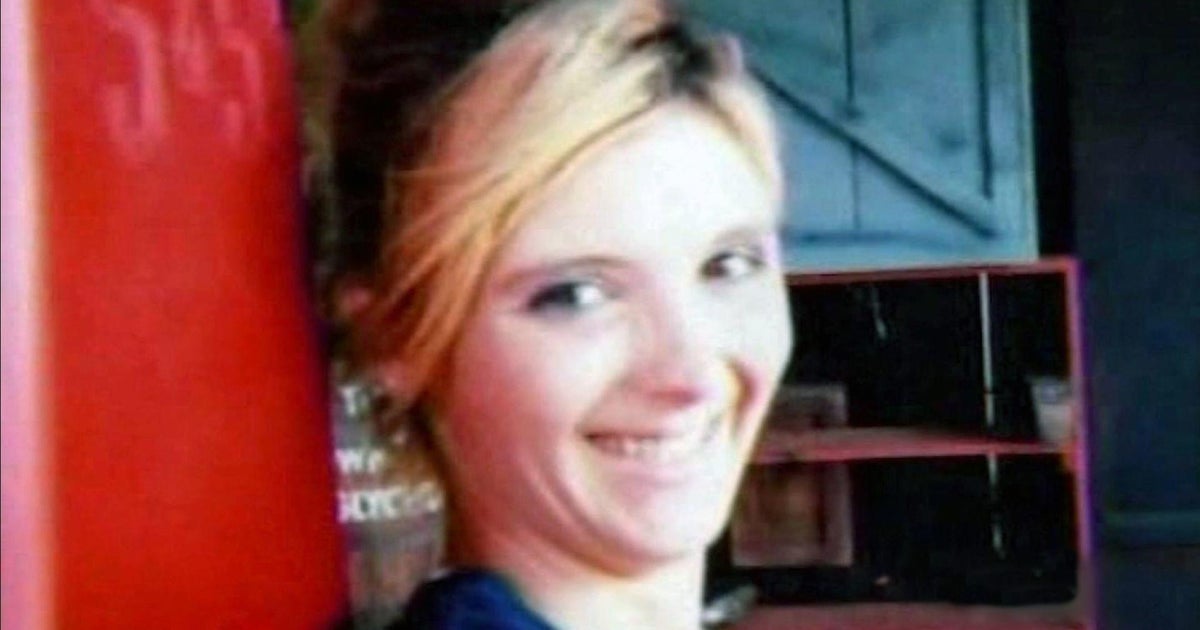"Lizzie Borden took an axe" — or did she? What would a jury say today?
[This story previously aired on December 26, 2020.]
It was an unspeakable crime. A double homicide that captured the attention of the entire nation.
"48 Hours" and correspondent Erin Moriarty are taking a fresh look at a cold case … a very cold case. It happened in 1892 and we're presenting it to a new jury to see if they can separate fact from fable.
The defendant was the 32-year-old daughter of the victims. Her name: Lizzie Borden.
Cara Robertson: The crimes were so violent … that many thought that Jack the Ripper had come to America.
Los Angeles author Cara Robertson has been living with Lizzie Borden for a long time.
Cara Robertson: I began to study Lizzie Borden when I was an undergraduate. I was interested in trying to find a topic for my college thesis.
Thirty years later, her thesis became a remarkably detailed look at the accusations against Lizzie Borden and her high-profile trial. "The Trial of of Lizzie Borden," was published by Simon and Schuster, a division of Viacom/CBS.
Cara Robertson: Fundamentally, the case was about whether or not someone like Lizzie Borden could have committed these brutal crimes.
And in 1893, a jury of 12 men agreed she couldn't, returning a unanimous verdict of not guilty.
Cara Robertson: This was the kind of crime that just could not have been committed by a woman.
But despite being acquitted, time and popular culture have forever cast Lizzie as one of America's most notorious killers. So, did she do it or not?
To help get to the bottom of this mystery, "48 Hours" brought together a team of paid consultants.
Two extremely experienced lawyers.
Anna-Sigga Nicolazzi: My name is Anna-Sigga Nicolazzi. I was a prosecutor for 21 years at the Brooklyn D.A.'s Office.
Matt Troiano: My name is Matthew Troiano. I'm a criminal defense attorney in New Jersey.
And two equally seasoned investigators.
Erin Rubas: My name is Erin Rubas and I am a crime scene investigator and a former homicide detective.
Andrew Schweighardt: I'm Andrew Schweighardt. I'm a Criminalist at the New York City Office of the Chief Medical Examiner.
Anna-Sigga Nicolazzi: I was sucked right in. I was sucked in from the perspective that this happened over 100 years ago.
Matthew Troiano: I think it's relevant now the same way it was relevant then. And it's just a fascinating story.
That story begins in Fall River, Massachusetts in1892.
Prominent local businessman Andrew Borden was wealthy, but also frugal, choosing to live there with his second wife Abby Borden, just a block from the center of town. The house is modest, even by 1890s standards, with almost no indoor plumbing or gas lighting.
Erin Moriarty: He was cheap …
Cara Robertson: He was known to be at the extreme end of Yankee frugality.
You can't analyze the crime without seeing where it all took place. So "48 Hours" brought crime scene investigator Erin Rubas to the Borden house.
Erin Moriarty [outside Borden house]: What is important? What do you really wanna see for yourself?
Erin Rubas: I wanna be able to take myself back into the crime scene, based on what I've read. I want to be able to kind of put those pieces together that are missing.
And she is able to do that because the house, oddly enough, is now a bed and breakfast, and restored in the style of the time, complete with actual crime scene photos and displays.
Erin Moriarty [inside dining room]: To your left is a replica of Andrew Borden's skull. And to your right is Abby Borden.
Erin Rubas: I would definitely say that whoever did this, this was personal, this was a lot of anger, and a lot of rage.
Cara Robertson: Lizzie Borden is a fairly unremarkable woman. … She was unmarried. … She was active … in her local church. … Emma Borden is Lizzie's Borden's older sister. And always played a bit of a maternal role with respect to Lizzie.
Emma, at the time of the murders, had been out of town for two weeks visiting friends.
Erin Moriarty: And Abby Borden? How would you describe Abby Borden?
Cara Robertson: Abby Borden, she's often cast in the story as the, you know, the evil stepmother. But in fact, she may well have been the nicest person in the house.
Which brings us to the late morning of August 4, 1892. Lizzie, standing at the side door of the house, tells her next-door neighbor Adelaide Churchill that her father has been killed.
Erin Moriarty: And does the neighbor see any blood on Lizzie?
Cara Robertson: The neighbor comes over directly and sees absolutely no blood.
Erin Moriarty: Nothing on her face, her hands, her clothing?
Cara Robertson: Nothing. She seems — perfectly presented.
Police found Lizzie's father stretched out on the couch in the sitting room bludgeoned to death.
Erin Rubas: [in the house looking at a photo] It's pretty brutal. It's definitely — I mean, his entire face is brutally bashed in.
But what of Andrew's wife Abby? Lizzie, sitting in the kitchen with that neighbor Adelaide Churchill, offers an answer.
Cara Robertson: She remarks that she thinks perhaps she heard her stepmother come in. At which point, Bridget Sullivan [the maid] and Adelaide Churchill, the next-door neighbor, go upstairs and find the body of Abby Borden.
Erin Moriarty: [in the guestroom]: This right over here is where Abby Borden is found dead, face down.
Cara Robertson: That scene is, if anything, more horrible. … Abby suffered 19 blows. … She's face down and much of her the back of her head has been hacked.
Cara Robertson: You can imagine the pressure that was on the police to come upon a scene like that. … The assumption at first was that it must have been a deranged outsider because the crimes were so shocking. But when it became clear that no one had been spotted in the vicinity … then suspicion turned to the people in the house.
Erin Rubas: The house was triple locked in the front door, and the back door was locked. And the only door that could have been unlocked was the side door.
Cara Robertson: They had to find a suspect. And they fastened upon Lizzie Borden as an obvious choice.
Anna-Sigga Nicolazzi: She is the only one that could've committed these crimes.
WHERE'S THE BLOOD?
On Saturday August 6, while Andrew and Abby Borden were being laid to rest, news of their murder was spreading far and fast.
Cara Robertson | Author: The brutality of the murders alone was enough to make this front-page news across the country.
At the same time, the Fall River Police Department was beginning its investigation.
Erin Moriarty: How would you describe the state of forensics in 1892?
Andrew Schweighardt | Criminologist: It was very primitive. … I think in many ways it was the perfect time for somebody to potentially get away with a crime like this.
Besides police, the Borden house was crowded with doctors, reporters, neighbors, and even several passersby.
Andrew Schweighardt: So, anything really that was discovered at that crime scene was seriously compromised because we don't know when or by whom it was deposited.
Cara Robertson: They take up pieces of carpet. They … count blood stains. … They search for evidence … of blood on any clothing.
What they find, though, are more questions than answers. One fact is clear: Abby was killed before Andrew.
Andrew Schweighardt: His death was so recent that his injuries were noted to have been oozing wet, liquid blood. He was also warm to the touch. On the other hand, Abby, who was upstairs, had matted, coagulated blood, dark blood on her injuries. She was also cold to the touch.
Five days later, during a police inquest, Lizzie gives her version of what happened that morning.
Cara Robertson: Five people wake up in the Borden house. … Andrew and Abby Borden, Lizzie Borden, the housemaid, Bridget Sullivan, and Lizzie's uncle, John Morse.
Andrew's brother-in-law, John Morse, visiting from out of town, was staying in the guest room.
Erin Moriarty [in the Borden guest room] This is where John Morse had stayed the night before.
Cara Robertson: We know that John Morse left in the morning to go visit other relatives in a different part of town. … And Andrew Borden … walked into the center of town to visit some of the buildings that he owned. Abby Borden went upstairs to clean up the guest room.
Lizzie says that she was in the dining room ironing. And Bridget Sullivan was outside washing windows when, about 9:30 in the morning, police believe Abby Borden fell to the floor, murdered.
Cara Robertson: Abby Borden was … a short woman. But she weighed about 200 lbs.
Erin Moriarty: And did Lizzie hear anything at all?
Cara Robertson: She claims not to have heard anything.
According to Lizzie's testimony, Andrew returned home at 10:45 a.m., greeting both the housekeeper and Lizzie, and then retired to that sitting room to take a nap on the couch. According to the medical examiner, 45 minutes later, Andrew Borden was also dead.
Erin Rubas: [in Borden house looking at couch]: That was the opportunity right there. … He's on that couch, and he's sleeping … and there was your opportunity.
Police were sure they had the "when," but there was still the question of "why." What was the motive? Lizzie may have given police that answer during the inquest.
Erin Rubas: Lizzie and her sister, Emma, both really desired to live a way better life, and they really resented their father for not providing that for them.
Cara Robertson: Andrew decided, essentially, to bail out his wife's half sibling by buying a house and putting it in Abby's name. … And thereafter, you find — that the house is a scene of a cold war.
Erin Rubas: Clearly Lizzie was not happy that that house was going to go her stepmother's sister.
Erin Moriarty: But enough to provide a motive for that kind of vicious killing?
Erin Rubas: They were brutal.
Certainly brutal enough to mark the perpetrator with evidence.
Erin Rubas [in sitting room]: I would think there would definitely be blood on her.
And yet…
Cara Robertson: One of the most fascinating parts of this case is that … except for around the bodies, there's no blood found anywhere.
If, in fact, Lizzie Borden is the killer, how did she not have any blood spatter on her? Her neighbor said she was spotless. So, where was the blood? Police searched the house and only found two instances of blood evidence: a minute spot on one of Lizzie's undergarments and a bucket of bloody cloths in the cellar washroom. Lizzie gave them a very personal explanation for both. She was menstruating.
Erin Rubas: I think that back then it was such a personal issue that, let's face it, who's going to challenge that?
Andrew Schweighardt: If we were to have that today, could we show, OK, is this Lizzie's blood? Or is it Andrew and Abby's blood?
Also puzzling and very suspicious: Lizzie's choice to burn a dress in the kitchen stove the day after her father's funeral.
Cara Robertson: Lizzie and Emma claimed that the dress had been stained with paint and … needed to be burned. And they thought that was as a good a time as any.
Andrew Schweigardt: For me the most valuable piece of evidence … is the dress that Lizzie burned. If she's responsible for this, it would have blood from the victims on it. And that would be very difficult for Lizzie to explain.
And with no dress, there was nothing to explain. It seemed the more they looked the less investigators found. Until down in the cellar …
Erin Moriarty [in the basement]: It says here that the hatchet was found …
Cara Robertson A particular hatchet head was found in a box of abandoned tools.
It became known as the "handleless hatchet" and would be a subject of debate for years to come.
Cara Robertson: It only had a piece of a handle. And according to the police, it was a fresh break.
Andrew Schweighardt: This particular hatchet head almost looked like it had been deliberately covered with a layer of ash.
Cara Robertson: It's about 3-and-a-half inches of a cutting blade. And that seemed consistent with the wounds on Andrew and Abby's body.
Andrew Schweighardt: She could've … quickly rinsed off that hatchet head, thrown it in a pile of ash to obliterate any … lingering blood, and then just tossed it in the cellar to make it look like an old piece of junk.
Erin Rubas [in Borden house]: There are endless places in this house to hide stuff …
If it was the murder weapon, police later discovered it might not have been Lizzie's first weapon of choice.
Cara Robertson: Someone who was identified as Lizzie Borden tried to buy prussic acid the day before the murders.
In 1892, prussic acid, a lethal poison, was only available with a doctor's prescription.
Cara Robertson: The woman … said that she needed it to put an edge on a seal-skin cape. And we know that Lizzie Borden did, in fact, have seal-skin capes.
But the pharmacist said he never heard of it used that way and refused to sell it to her.
Cara Robertson: And then because she was unable to get the poison, she turned instead to a readily available household implement.
Erin Moriarty: The hatchet?
Cara Robertson: That's right [chuckles].
It would seem the police came to the same conclusion and at the close of the inquest, the chief of police placed Lizzie Borden under arrest for murder.
THE TRIAL OF THE 19TH CENTURY
On June 5,1893, 10 months after her arrest, Lizzie Borden sat in the superior court in New Bedford, Massachusetts on trial for murder.
Cara Robertson: The first day of Lizzie Borden's trial – attracted – a massive crowd, reporters were detailed from around the country. …People waited for hours in line.
It was called the trial of the century … the nineteenth century.
Cara Robertson: What I think is striking … is that many of the people most interested in the case were women.
Erin Moriarty: Why? Why are these women willing to put aside their lives to attend the trial?
Cara Robertson: This was the trial of a woman who seemed to have transcended the limits of her sex in such a violent way. The women, I think, were curious to see…the monster."
While they were welcome to watch, at the time, women were not allowed to sit on the jury.
Cara Robertson: There won't be, in fact, women jurors until 1951 in Massachusetts.
Despite the rigid standards of the times, the proceedings of the trial were surprisingly familiar to our consulting attorneys.
Matthew Troiano | Defense attorney: From what I've read, you could take this trial transcript … and put it into 2020 and it would basically be the same.
Anna-Sigga Nicolazzi | Prosecutor: Both the prosecutors and the defense attorneys came in with a lot of the same arguments that I would imagine today.
In front of a panel of three judges and a jury of 12 men, the prosecutor began his opening statement with a simple premise.
Cara Robertson: … that Lizzie Borden is the only person with the opportunity and the motive to have committed the crimes.
But it was how he wrapped up his open that stunned the courtroom.
Cara Robertson: He alludes to the fact that he has the skulls of the victims.
Erin Moriarty: So, the prosecutor has the actual heads of the victims in the courtroom?
Cara Robertson: Yes. … And Lizzie Borden responds by fainting.
Over the next week, the jury hears from a parade of prosecution witnesses.
Cara Robertson: The prosecution works very methodically and lays out the evidence.
Evidence of who was killed first …
Anna-Sigga Nicolazzi: If Andrew had been killed first, then automatically Abby's family will get part of the money … where if she's killed first, everything is just for the girls.
Evidence matching the skulls to the suspected murder weapon …
Andrew Schweighardt: …to show that the dimensions of the injuries on the skull … aligned with the dimensions of the most probable murder weapon which was the hatchet.
And testimony of Lizzie's ability to wield that hatchet.
Cara Robertson: The medical experts all said that a woman of ordinary build and ordinary strength could have committed the murders.
But there is one thing the judges don't allow the jury to hear.
Cara Robertson: Some of the prosecution's best evidence is kept from the jury. Most notably … her … alleged attempts to buy prussic acid before the murders.
Anna-Sigga Nicolazzi: If she's out there getting poison, that is absolutely something the jury should consider when two people in her home were found dead the next day.
Erin Moriarty: Was it right to keep that out?
Matthew Troiano: As a defense attorney, sure, right? Hugely prejudicial, not really relevant.
After nine days, the prosecution rests and Lizzie's defense team goes to work.
Cara Robertson: The defense is much more interested in telling a story… that she's just an ordinary person caught in this unbelievably horrible situation.
Matt Troiano: Clearly, there's a lack of evidence. And then there's a second part of, "Hey, we just don't think that she did this."
The defense needed only two days of witness testimony to make its case, and it's a case for reasonable doubt.
Matthew Troiano: You cannot answer the questions that have to be answered here, and that's reasonable doubt.
Erin Moriarty: What was … the most powerful defense?
Cara Robertson: The most powerful witness in her defense was her sister Emma. Emma testified that it was her idea, rather than Lizzie's to burn the dress. Which makes it seems like it was a much more innocent thing to do.
Lizzie Borden never testified and after 3 weeks, the trial ended with closing arguments. But before the jury was charged, Lizzie did have the last word.
Cara Robertson: And she says, "I am innocent. I leave it to my counsel to speak for me."
And with that, the case went to the jury.
Cara Robertson: The courtroom is packed. People are also standing … out in the corridors and around the front of the building waiting for some kind of word.
They didn't have to wait long. The jury took less than two hours to reach a verdict.
Matthew Troiano: The foreman, it's reported, almost can't contain his excitement …
Cara Robertson: "… and just says, "Not guilty."
Erin Moriarty: Just blurts it out?
Cara Robertson: Blurts it out, yeah.
Cara Robertson: At that point, Lizzie Borden falls into her chair as if shot, and puts her head on the rail. … Meanwhile, the courtroom erupts into cheers. And there are cheers outside that could be heard a mile away.
Anna-Sigga Nicolazzi: Maybe this is the prosecutor in me, but I was shocked she was acquitted. … It is so clear to me, as much as it can be, that she is guilty.
Matthew Troiano: Now, whether or not they thought it was "not guilty" or "innocent," who knows? But they certainly didn't think she was guilty.
Andrew Schweighardt: And I think at the end of the day they just didn't wanna believe that such a terrible, horrific crime could've been done by somebody like Lizzie Borden.
But now in 2020, would a jury of men and women come to the same conclusion?
DID LIZZIE DO IT?
In 1893, Lizzie Borden was found not guilty by a jury of 12 men who couldn't believe a woman was capable of such acts of extreme violence. But how would a jury of men and women vote in 2020?
To try and answer that question, "48 Hours" hired a jury recruiting firm to find us a panel of men and women who had never heard of Lizzie Borden and then paid them to decide the case. This is not a retrial, but a presentation, argued by our consulting attorneys, in their own words, without any guidance from "48 Hours."
Erin Moriarty [to jurors]: This is the case of Lizzie Borden.
The rules were simple. Only evidence presented in the original trial could be presented here, and all facts should be presumed to be true
Prosecutor Anna-Sigga Nicolazzi and defense attorney Matthew Troiano delivered their opening statements:
ANNA-SIGGA NICOLAZZI: This case is about bitterness, resentment and fear. … Greed was what drove Lizzie Borden to do what she did. … Just one night before these two innocents are bludgeoned in their own home, the defendant goes to see a friend. … She, out of nowhere volunteered she'd been feeling depressed and so worried about many nameless, faceless enemies that her father had. … And she left with this: "I'm afraid something's going to happen." … Lizzie Borden is guilty of her parents – her father and her stepmother's murder. And the evidence by the end will prove that to you beyond any reasonable doubt. Thank you.
MATTHEW TROIANO: This is a woman of 32 years old who is accused of the most vicious and heinous murder that one could imagine. … What would you expect to see all around the person and on the person that did this? Blood? A lot of blood, right? … There's no blood on her at all…. There's no blood on her hands. There's no blood on her face. … There's no blood anywhere on her. … The reality here, ladies and gentlemen, is the evidence is lacking. The story is good, but the evidence is lacking. And if you are going to come back and convict somebody of this crime … you better get a little bit more than a story. … Thank you.
Next, prosecutor Nicolazzi calls on her experts to explain the evidence: the locked doors, the hatchet, the pail of bloody rags and that burned dress. But it's the blood evidence, or rather the lack of it, that is her biggest challenge:
ERIN RUBAS | Crime scene investigator: It is my belief that this was done from someone facing him and directly almost over top of him.
ANNA-SIGGA NICOLAZZI: And it's fair to say that even with that number of wounds, there was not … a whole lot of blood.
ERIN RUBAS: That's correct.
ANNA-SIGGA NICOLAZZI: With Abby Borden, how many wounds were observed on her body?
ANDREW SCHWEIGHADRT | Criminologist: There were 19 wounds observed on Mrs. Borden, 18 to the back of her head on the right side and one at the base of her neck.
ANNA-SIGGA NICOLAZZI: Possible to commit those murders and not get a lot of blood on you, based on the type of wounds that we had?
ERIN RUBAS Absolutely.
ANNA-SIGGA NICOLAZZI: Did he have any defensive wounds?
ERIN RUBAS: None that were observed.
And why wouldn't the victims fight back?
ANNA-SIGGA NICOLAZZI: If someone sees someone who is familiar … could that contribute to a lack of initial defensive wounds?
ANDREW SCHWEIGART: Possibly.
ANNA-SIGGA NICOLAZZI: Did they recover anything in terms of any possible weapon?
ERIN RUBAS: A hatchet head.
ANNA-SIGGA NICOLAZZI: Is there anything about the size of the actual hatchet that was recovered that would preclude a woman from using it?
ERIN RUBAS: No.
ANNA-SIGGA NICOLAZZI: No matter the size?
ERIN RUBAS: No matter the size.
ANNA-SIGGA NICOLAZZI: I have nothing further.
The defense's cross-examination, Troiano again focuses on the lack of blood:
MATT TROIANO: You would agree that at the point that obviously the object hits that source of blood, there's going to be blood that comes out from it? Is that correct?
ERIN RUBAS Yes. I think that does depend on the specifics. But yes.
MATT TROIANO: But certainly, as far as you know, there was no dress that was found that would have had blood spatter on it. Is that correct?
ERIN RUBAS: Correct.
MATT TROIANO: The only blood that is on an article of clothing … was a 1/16 inch-size pinhead spot of blood on an underdress underneath an outer dress.
ANDREW SCHWEIGARDT: That's correct. That was the only piece of blood that was detected.
MATT TROIANO: Any blood on that hatchet?
ERIN RUBAS: Not that was observed.
And in 1892, with no scientific testing available, observation was the best and only tool at hand.
MATT TROIANO: No other apparent blood anywhere else … in the house. Is that correct?
ANDREW SCHWEIGARDT: Other than blood in the immediate two areas of the two homicides and potential blood in the pail in the cellar, there was no mention of blood elsewhere in the case record.
MATT TROIANO: I think that's all I have. Thank you.
And then both lawyers make their final arguments to the jury:
MATT TROIANO: I think what you've heard over the course of the last couple hours are questions … but not proof and not proof beyond a reasonable doubt.
ANNA-SIGGA NICOLAZZI: This case is very much like a jigsaw puzzle. But I suggest that when you look at all those pieces, it's not one that is overly tough to solve.
MATT TROIANO: You are not here to find a solution to the puzzle.
ANNA-SIGGA NICOLAZZI: You are here to decide if a crime was committed and if this person, the defendant, Lizzie Borden, committed it. And all the pieces of evidence say yes.
MATT TROIANO: There is no direct evidence here, right? And the circumstantial evidence is so very weak that it can't be enough. … So, think those things through. I know you will. … Thank you very much.
ANNA-SIGGA NICOLAZZI: The evidence is all there. When you use all of it and use your common sense … it is proof of one thing: Lizzie Borden, the defendant, bludgeoned her stepmother and her father to death. … And for that, you should find her guilty. Thank you.
And with that, once again, Lizzie's fate is in the hands of a jury.
What's different this time is these lawyers get to hear the jury deliberate.
THE SURPRISING VERDICT
More than a century after Lizzie Borden went on trial for murder, a jury of eight people have been asked to wrestle with many of the same questions.
It's an unheard opportunity to be in the room for an actual deliberation. It quickly becomes clear that there are no easy answers for our jurors: Frank, James, Michele, Aimee, Michael, Jarrell, Larysa, and Jennifer.
Erin Moriarty: What are the big concerns here?
Aimee: The prosecutor said resentment, bitterness and greed. … But it just seems like overkill if she wasn't going to lose everything. … Either she's a sociopath or possibly not guilty. And that's my only question.
Michael: I feel like to go for first-degree murder of both victims, there has to be malice and forethought, and I don't believe that was proven.
Erin Moriarty: Well, you know these are two different counts. So, if you wanted to, you could decide that she's guilty of one and not guilty of the other.
Jarrell: Abigail was struck 19 times. Like you said, that is overkill. But there's still a lot of, like I said, unknowns in terms of how do they clean that that up?
Jennifer: I can't figure out how she could've done it and been standing there with nothing - like nothing on her, like house and everything normal.
Michael: I feel like it hast to be It has to be someone familiar with the house.
Michele: Also familiar with the victims, because … they are clearly familiar with the attacker.
Laryza: I'm not convinced beyond reasonable doubt that she's guilty. … I don't buy it.
Aimee: But I don't think the standard is "completely convinced." It's beyond a reasonable doubt. But that doesn't mean completely.
Unlike the original jury, this panel has no trouble believing a woman could kill. The question is: was it this woman?
Michael: If she does know how to kill a pig or livestock, then she knows how to do it right.
They believe she had the motive.
Jennifer: She hated her stepmother.
But there were still questions.
Jarrell: Why leave Bridget alive?
Michael: Why leave the bloody rags just hanging out?
Frank: Listen, let's forget about accomplices or her motivation. The question is, did she do it?
Erin Moriarty: So, do you want to, you know, take a vote from everybody on two different counts?
After almost an hour of deliberation, the jurors took a vote.
Erin Moriarty: On the charge of first degree with the death of Abby Borden?
Frank: Guilty.
Aimee: Guilty.
Michael: Guilty.
James: Guilty.
Michele: Guilty.
Jennifer: Guilty.
Laryza: I keep going back to she looks guilty, but I'm not convinced, so I'm back to not guilty.
Erin Moriarty: You're the last one Jarrell.
Jarrell: Guilty. Yeah. Guilty.
Erin Moriarty: You're sure?
Jarrell: Yes. Positive on that one.
Erin Moriarty: On the charge of first degree with Andrew Borden?
Frank: Guilty.
Aimee: Guilty.
Michael: Guilty.
James: Guilty
Michele: Guilty.
Jennifer: Guilty.
Laryza: Not guilty.
Jarrell: Not guilty.
While Jarrell was confident Lizzie had planned to kill Abby, he believed the murder of her father was purely spontaneous.
Jarrell. I just – I don't know if that premeditation factored in with dad.
And with that, the foreman published the jury's verdict
Jennifer: On the charge of first-degree murder of Abby Borden, we are a hung jury. And on the charge of first-degree murder for Andrew Jackson Borden, we are also a hung jury. Thank you.
Cara Robertson: There's still something profoundly unsettling about the idea that – a woman who seems normal – committing a crime like this.
Erin Moriarty: We heard most of these jurors vote to convict her. But you heard a lot of doubt there.
Matt Troiano: There was a lot. There were a number of them that were expressing doubt. And, you know, you wonder, is that a misunderstanding of the standard? … Or is it just they're making a call, right? … It was fascinating. But at the same time, troubling at times as well.
Anna-Sigga Nicolazzi: I think if you really broke it down, those that voted for guilty at the end really did express that they did think it was her and that the evidence had proven it, while they may not have expressed it that clearly in that one thought.
Erin Moriarty: So, is it fair to say that we've not solved the mystery of Lizzie Borden and it will be argued for another 120-something years?
Anna-Sigga Nicolazzi: I feel like we've solved the mystery of Lizzie Borden. We just haven't solved whether she should have been found guilty or not. Because it's a very different question.
Matt Troiano: I think that that's the best way to say it. And maybe that's the beauty of the system and maybe it's not.
Clearly, Lizzie Borden didn't care what people thought of her. After her acquittal, she wasted little time getting on with her life. She stayed in Fall River, just not in the home where the murders happened.
Cara Robertson: She and her sister Emma – promptly vacate the cramped family house that was a source of some dissatisfaction.
Inheriting almost $350,000 from their father's estate, which would be $10 million in today's money, Lizzie and Emma bought the house they always wanted at the top of the hill in the wealthy part of town.
Cara Robertson: She changed her name from Lizzie to Lisbeth. And she named her house, Maple Croft.
It seemed, well, unseemly to many in the community.
Cara Robertson: Very soon there are people who start to wonder, "If it wasn't Lizzie Borden, then who was it?" … Lizzie Borden finds herself unwelcome at the church where — she had spent so much of her time — and which had provided the foundation of her support during the trial.
Twelve years later, even Lizzie's sister Emma turns her back on her.
Cara Robertson: Emma was deeply troubled by something that was going on in the house such that she felt it was necessary to sever all ties with her sister.
Lizzie, who never married, finished out her life as a recluse, alone in her home with her dogs, until her death in June of 1927.
Erin Moriarty: Did Lizzie ever talk to the press? Did she ever give her side of the story?
Cara Robertson: No. Lizzie Borden remained silent.
Coincidently, Emma, living in New Hampshire, died just nine days later. They were both laid to rest alongside their father and stepmother.
Today, Fall River, Massachusetts, embraces the woman who brought so much notoriety to the town.
Anna-Sigga Nicolazzi: Lizzie Borden took an axe …
Matthew Troiano: … and gave her mother 40 whacks.
Erin Rubas: … When she saw what she had done …
Andrew Schweighardt: … she gave her father 41.
Last May, Lizzie Borden's house was sold for $1.8 million.
It is still a museum and bed and breakfast.
MY LIFE OF CRIME PODCAST
Could you spend the night at the scene of a crime? Listen to Erin Moriarty's "My Life of Crime" podcast to hear about her stay at the Borden home.
Produced by Josh Gelman. Hannah Vair is the associate producer. George Baluzy, Greg McLaughlin and Mike Vele are the editors. Patti Aronofsky is the senior producer. Nancy Kramer is the executive story editor. Judy Tygard is the executive producer.



